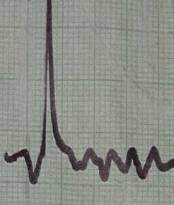|
|
In May of 2008 I placed a salt and water filled xylem wood sample in an aluminum shield and pulsed it with 9 volts dc through steel contacts on the ends. I found that another sample in a metal box placed some distance away returned the signal and the two samples oscillated together for a short periods of time after pulsing the transmitting sample. What was important was that the signals were penetrating the aluminum shields. The signals were found to be traveling about 25 m/s! The two characteristics, shield and other matter penetration and low velocity, apparently characterize dark matter. Going back to my plant communication experiment in 1989 I found a large timing error1. The corrected velocity there was also found to be about 25 m/s. Apparently the waves that I find in plants are related to dark matter waves which I have hypothesized for many years (see my references). The signal from the pulsed shielded sample was also found to oscillate with two trees: a tree at 7 m away and one at 43.6 m away. The period of oscillation was found to be proportional to the distance which again indicated about 25 m/s. Note that the waves within plants are also matter penetrating waves. Since dark matter doesn’t interact much electromagnetically it penetrates ordinary matter as in the sun2. See Figure 1 for the response from the tree at 43.6 m from the shielded pulsed sample.

Note that the sharpness of the edges of many of the rings of the gaseous planets indicate that gravity is not alone in what shapes the rings but that dark matter oscillations of planetary layers provide the confinement that holds the rings in place indefinitely. See the article Dark Matter Waves and Planetary Rings. See also Perhaps Gravitational Waves Do Not Exist
References
(1) O.E. Wagner, W-waves and plant communication, Northw. Science 63(3), 119-128 (1989).
(2)O.E. Wagner, Waves in dark matter. Physics Essays 12(1), 3-10(1999).
(3)J.M. Frere, F.S. Ling, and G. Vertongen, Bound on the dark matter density in the solar system from planetary motions. Phys. Rev. D77(8), 083005(2008).
| Copyright ©2009-2018 Wagner Research Laboratory |